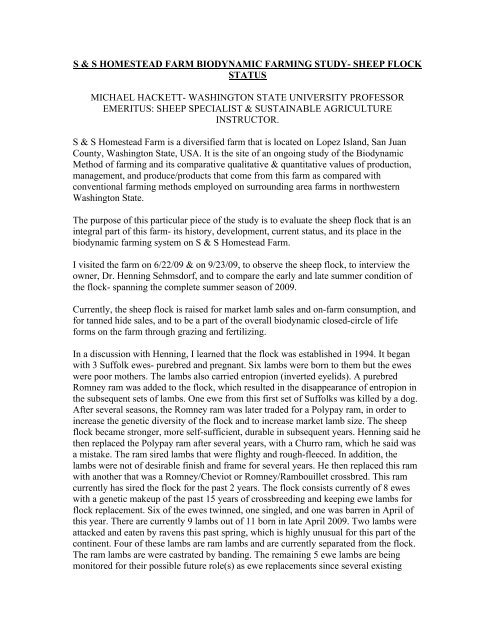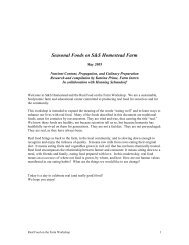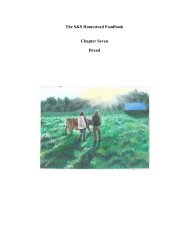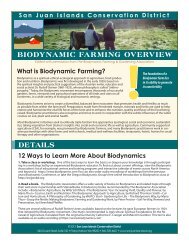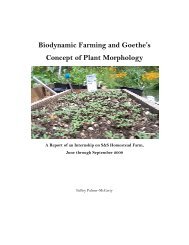s & s homestead farm biodynamic farming study - S&S Homestead ...
s & s homestead farm biodynamic farming study - S&S Homestead ...
s & s homestead farm biodynamic farming study - S&S Homestead ...
Create successful ePaper yourself
Turn your PDF publications into a flip-book with our unique Google optimized e-Paper software.
S & S HOMESTEAD FARM BIODYNAMIC FARMING STUDY- SHEEP FLOCK<br />
STATUS <br />
MICHAEL HACKETT- WASHINGTON STATE UNIVERSITY PROFESSOR<br />
EMERITUS: SHEEP SPECIALIST & SUSTAINABLE AGRICULTURE<br />
INSTRUCTOR.<br />
S & S <strong>Homestead</strong> Farm is a diversified <strong>farm</strong> that is located on Lopez Island, San Juan<br />
County, Washington State, USA. It is the site of an ongoing <strong>study</strong> of the Biodynamic<br />
Method of <strong>farm</strong>ing and its comparative qualitative & quantitative values of production,<br />
management, and produce/products that come from this <strong>farm</strong> as compared with<br />
conventional <strong>farm</strong>ing methods employed on surrounding area <strong>farm</strong>s in northwestern<br />
Washington State.<br />
The purpose of this particular piece of the <strong>study</strong> is to evaluate the sheep flock that is an<br />
integral part of this <strong>farm</strong>- its history, development, current status, and its place in the<br />
<strong>biodynamic</strong> <strong>farm</strong>ing system on S & S <strong>Homestead</strong> Farm.<br />
I visited the <strong>farm</strong> on 6/22/09 & on 9/23/09, to observe the sheep flock, to interview the<br />
owner, Dr. Henning Sehmsdorf, and to compare the early and late summer condition of<br />
the flock- spanning the complete summer season of 2009.<br />
Currently, the sheep flock is raised for market lamb sales and on-<strong>farm</strong> consumption, and<br />
for tanned hide sales, and to be a part of the overall <strong>biodynamic</strong> closed-circle of life<br />
forms on the <strong>farm</strong> through grazing and fertilizing.<br />
In a discussion with Henning, I learned that the flock was established in 1994. It began<br />
with 3 Suffolk ewes- purebred and pregnant. Six lambs were born to them but the ewes<br />
were poor mothers. The lambs also carried entropion (inverted eyelids). A purebred<br />
Romney ram was added to the flock, which resulted in the disappearance of entropion in<br />
the subsequent sets of lambs. One ewe from this first set of Suffolks was killed by a dog.<br />
After several seasons, the Romney ram was later traded for a Polypay ram, in order to<br />
increase the genetic diversity of the flock and to increase market lamb size. The sheep<br />
flock became stronger, more self-sufficient, durable in subsequent years. Henning said he<br />
then replaced the Polypay ram after several years, with a Churro ram, which he said was<br />
a mistake. The ram sired lambs that were flighty and rough-fleeced. In addition, the<br />
lambs were not of desirable finish and frame for several years. He then replaced this ram<br />
with another that was a Romney/Cheviot or Romney/Rambouillet crossbred. This ram<br />
currently has sired the flock for the past 2 years. The flock consists currently of 8 ewes<br />
with a genetic makeup of the past 15 years of crossbreeding and keeping ewe lambs for<br />
flock replacement. Six of the ewes twinned, one singled, and one was barren in April of<br />
this year. There are currently 9 lambs out of 11 born in late April 2009. Two lambs were<br />
attacked and eaten by ravens this past spring, which is highly unusual for this part of the<br />
continent. Four of these lambs are ram lambs and are currently separated from the flock.<br />
The ram lambs are were castrated by banding. The remaining 5 ewe lambs are being<br />
monitored for their possible future role(s) as ewe replacements since several existing
ewes may be ready for replacing. Those not chosen for ewe replacements will be<br />
slaughtered. These decisions had not yet been made as of the date of the last visit to the<br />
<strong>farm</strong>.<br />
The key here is to note that unlike other conventional sheep production models, the flock<br />
is of a stable number- from 6-8 ewes and one ram, each year. This has been determined<br />
by Henning to be sustainable, given the forage availability of the <strong>farm</strong>, the niche filled by<br />
the flock in the whole-<strong>farm</strong> <strong>biodynamic</strong> system, the current customer base, and the labor<br />
required for this flock.<br />
The 2009 lamb crop was observed and evaluated for health, growth rate and frame<br />
condition during the two visits- also in a comparative manner, through a 95-day period<br />
during the summer of 2009. The condition of the ewes was also observed during these<br />
visits. It is important to note that this flock is closely monitored by Henning daily. This is<br />
in contrast to the conventional <strong>farm</strong>ing model of leaving the flock to fend for itself<br />
through the summer. Other differential points include the fact that the lambs are not ever<br />
weaned- they stay on their dams until they are almost ready for slaughter. There have<br />
been over the years, two major slaughter times- spring and fall. The lambs are<br />
slaughtered on the <strong>farm</strong> using either a state- or USDA-inspected a mobile unit (depending<br />
on requirements) and processed at an off-island site.<br />
In my observations regarding the conditioning of the lambs, including the comparisons I<br />
made in June with those in September, all of the lambs, ewe lambs and ram lambs, were<br />
growing at reasonable rates- averaging 0.3 pounds to 0.5 pounds per day. This is an<br />
acceptable rate of growth, even in a conventional sheep enterprise, and granting that these<br />
lambs are not of large frame size. It is also to be noted here that the customer base<br />
requests, and is satisfied with, the size of these market lambs, which may average from<br />
85-100 pounds at slaughter. Henning simply is satisfying his customer base. Singles are<br />
slaughtered in the fall of the year they were born, and twins are slaughtered as yearlings<br />
the following spring. It is important to note that the customer base continues to be willing<br />
to pay a premium for these lambs, due, in their words, to continual/consistent superior<br />
taste and tenderness. Another product that comes from this flock is tanned hides. The<br />
quality of the hides was observed to be superior to those which would have come from<br />
conventional sheep-raising systems regarding intact hides (no holes, tears, scarring).<br />
The sheep have year-round access to pasture. This pasture base, several fields involving a<br />
considerable number of paddocks, is more than sufficient nutrition for a flock of this size<br />
and scale. In addition, this flock is observed to thrive on this forage base.<br />
Note that the forage is sprayed with a <strong>biodynamic</strong> preparation and that forage testing has<br />
been conducted and found to be deficient in several nutrients. However, these results are<br />
held up to a standard, conventional model based on North American forage values that<br />
are strived for in a maximum-production system that is reductionist in its logic, and not<br />
applicable in this <strong>biodynamic</strong> <strong>farm</strong>ing system, wherein it is observed that that sheep that<br />
are grazing on it and growing satisfactorily from it, which in my opinion, is acceptable.<br />
The sheep, including the ewes and the lambs, are in top condition, both in body condition
scoring, through palpation and other measurements. This logic model suggests that, given<br />
the forage base, the forage palatability and readily apparent nutritional sufficiency to<br />
sustain this flock, it is an acceptable and even desirable situation that does not render the<br />
<strong>farm</strong>er to have to supply expensive, non-sustainable inputs such as fertilizers and other<br />
soil amendments in order to meet a conventional forage-base standard, which is measured<br />
solely on quantity of production. Further, this conventional benchmark would also<br />
assume that the forage field would be one, two or perhaps only a few species of grasses<br />
and/or legumes. In the case of the fields on this <strong>farm</strong>, they are populated with a multitude<br />
of species of legumes, grasses, and forbs. If maximum forage production was the goal,<br />
the <strong>farm</strong> could likely produce many times the forage it presently produces, with the<br />
recommended inputs/amendments/new plantings that the forage testing results and<br />
recommendations convey. Then, however, this would result in more labor, more<br />
equipment use, more forage storage, which is not the goal of this <strong>farm</strong>ing system.<br />
This system strives for stasis- a balanced, sustainable, interdependent, living organism.<br />
While this item is not directly connected to the sheep flock enterprise itself, it is<br />
nonetheless important to have discussed it. In another part of this overall <strong>study</strong>, it is<br />
addressed in a more detailed fashion. However, it reinforces the mission and the role of<br />
the sheep flock in this <strong>biodynamic</strong> system of integrated organisms. The <strong>farm</strong> benefits<br />
from this part of its <strong>biodynamic</strong> system (sheep) through a consciously-measured<br />
appropriate flock size, borne from 15 years of observation/experience, which utilizes the<br />
planned portion of the forage base satisfactorily, and keeps the fields healthy through<br />
even distribution of the manure from the roving flock which is managed through effective<br />
electronic fencing and informed, experienced observations by the <strong>farm</strong> staff as to<br />
managed grazing schedules that are based on forage growth, weather conditions, and<br />
flock behavior- and not simply by a set of pre-arranged dates for moving the animals to<br />
different paddocks. The actual grazing behavior is also monitored and although grazed<br />
forage height is a widely-accepted indicator of when to move animals, Henning and I<br />
observed that the seasonal, even monthly, forage palatability and nutritional content of<br />
forage may be of even greater importance than the height of the grazed forage before<br />
moving the flock to another paddock.<br />
It is also important to note that the flock is not wormed, nor vaccinated, nor have there<br />
been any illnesses for a number of years- only ravens have been responsible for<br />
reductions in the crop of lambs this year. Regarding lambing percentage as compared<br />
with that of conventional commercial flocks, it is similar- at about 140%.<br />
Regarding other feedstuffs in the sheep flock nutritional profile, a cup of barley per ewe<br />
per day is given in the early lactation, along with year-round access to loose trace<br />
minerals, due mainly to the soil being naturally low in Selenium. In addition, the lambs at<br />
4-6 weeks of age are given molasses for an energy boost if needed due to some cold<br />
and/or unusually wet spring seasons over the years.
Final observations/conclusion- my task was to observe and evaluate the S &S <strong>Homestead</strong><br />
sheep flock in several areas as a small part of an overall <strong>study</strong> of the <strong>biodynamic</strong> <strong>farm</strong>ing<br />
system that sustains this <strong>farm</strong>.<br />
1. The sheep flock is healthy and productive. This includes the ewes, the ram, and<br />
the current crop of lambs.<br />
2. This model of sheep production for meat and for tanned hides is appropriate and<br />
fitting for this <strong>farm</strong> and its dedication to <strong>biodynamic</strong> <strong>farm</strong>ing principles.<br />
3. The forage base on this <strong>farm</strong> is sufficient for this flock to be sustained.<br />
4. The flock currently produces lambs that are of ideal frame size and finish to meet<br />
the desires of the customer base which readily pays a premium for these lambs.<br />
5. This model cannot be compared fairly and impartially with that of a conventional<br />
<strong>farm</strong> sheep model. It is evaluated on its own, and it was evaluated as such, and it<br />
is found to be satisfactory.<br />
Respectfully submitted- Michael Hackett, Washington State University Professor<br />
Emeritus. 10/25/09.


